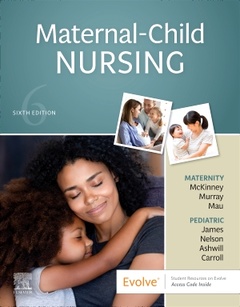Description
Maternal-Child Nursing (6th Ed.)
Authors: McKinney Emily Slone, James Susan R., Murray Sharon Smith, Nelson Kristine, Ashwill Jean
Language: English
Subjects for Maternal-Child Nursing:
Keywords
Approximative price 151.99 €
In Print (Delivery period: 14 days).
Add to cart1448 p. · Paperback
Description
/li>Contents
/li>
Build your skills in the science and art of maternity and pediatric nursing! Maternal-Child Nursing,6th Edition makes it easy to understand the essentials of women's health, maternity, and children's nursing care. It simplifies the steps of the nursing process and relates them to care, helping you develop clinical judgment skills and provide safe, effective care in evidence-based practice. This edition adds case studies preparing you for the new Next Generation NCLEX® examination. Best of all, active learning tools and features make it fun to master nursing concepts, offering plenty of opportunities to apply your knowledge to the practice setting.
- Nursing Care Planshelp students apply the nursing process to plan individualized care in the most common maternity and pediatric situations.
- Clinical Reference sections in pediatrics chapters provide basic information on disorders and their related anatomy and physiology, differences in body systems between children and adults, commonly used drugs, lab values, diagnostic tests, and procedures.
- Clinical Judgment boxes highlight situations designed to test clinical judgment skills.
- Health Promotion boxes highlight information needed to perform a comprehensive assessment of well infants and children at various ages.
- Safety Alerts emphasize what is important to remember when providing safe and optimal quality care.
- Pathophysiology boxes present an illustrated overview of illnesses and how to manage them.
- Want to Know boxes provide teaching guidelines, including sample answers for questions that are likely to be asked or topics that need to be taught.
- Communication Cues offer practical tips for verbal and nonverbal communication with patients and families.
- Glossary at the end of the book gives students quick access to all key terms and definitions.
- Nursing Care Planshelp students apply the nursing process to plan individualized care in the most common maternity and pediatric situations.
- Clinical Reference sections in pediatrics chapters provide basic information on disorders and their related anatomy and physiology, differences in body systems between children and adults, commonly used drugs, lab values, diagnostic tests, and procedures.
- Clinical Judgment boxes highlight situations designed to test clinical judgment skills.
- Health Promotion boxes highlight information needed to perform a comprehensive assessment of well infants and children at various ages.
- Safety Alerts emphasize what is important to remember when providing safe and optimal quality care.
- Pathophysiology boxes present an illustrated overview of illnesses and how to manage them.
- Want to Know boxes provide teaching guidelines, including sample answers for questions that are likely to be asked or topics that need to be taught.
- Communication Cues offer practical tips for verbal and nonverbal communication with patients and families.
- Glossary at the end of the book gives students quick access to all key terms and definitions.
Unit I: Introduction to Maternal-Child Health Nursing
- Foundations of Maternity, Women's Health, and Child Health Nursing
- The Nurse's Role in Maternity, Women's Health, and Pediatric Nursing
- The Childbearing and Child-Rearing Family
- Communicating with Children and Families
- Health Promotion for the Developing Child
- Health Promotion for the Infant
- Health Promotion During Early Childhood
- Health Promotion for the School-Age Child
- Health Promotion for the Adolescent
- Heredity and Environmental Influences on Development
- Reproductive Anatomy and Physiology
- Conception and Prenatal Development
- Adaptations to Pregnancy
- Nutrition for Childbearing
- Prenatal Diagnostic Tests
- Giving Birth
- Intrapartum Fetal Surveillance
- Pain Management for Childbirth
- Nursing Care During Obstetric Procedures
- Postpartum Adaptations
- The Normal Newborn: Adaptation and Assessment
- The Normal Newborn: Nursing Care
- Newborn Feeding
- The Childbearing Family with Special Needs
- Pregnancy-Related Complications
- Concurrent Disorders During Pregnancy
- The Woman with an Intrapartum Complication
- The Woman with a Postpartum Complication
- The High-Risk Newborn: Problems Related to Gestational Age and Development
- The High-Risk Newborn: Acquired and Congenital Conditions
- Management of Fertility and Infertility
- Women's Health Care
- Physical Assessment of Children
- Emergency Care of the Child
- The Ill Child in the Hospital and Other Care Settings
- The Child with a Chronic Condition or Terminal Illness
- Principles and Procedures for Nursing Care of Children
- Medication Administration and Safety for Infants and Children
- Pain Management for Children
- The Child with a Fluid and Electrolyte Alteration
- The Child with an Infectious Disease
- The Child with an Immunologic Alteration
- The Child with a Gastrointestinal Alteration
- The Child with a Genitourinary Alteration
- The Child with a Respiratory Alteration
- The Child with a Cardiovascular Alteration
- The Child with a Hematologic Alteration
- The Child with Cancer
- The Child with an Alteration in Tissue Integrity
- The Child with a Musculoskeletal Alteration
- The Child with an Endocrine or Metabolic Alteration
- The Child with a Neurologic Alteration
- Psychosocial Problems in Children and Families
- The Child with a Developmental Disability
- The Child with a Sensory Alteration
Unit II: Maternity Nursing Care
Unit III Pediatric Nursing Care
Glossary
These books may interest you

Maternity and Pediatric Nursing 167.20 €



